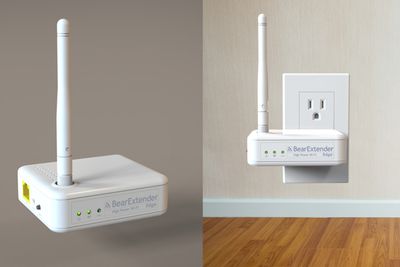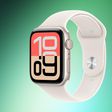BearExtender, known for its Wi-Fi enhancing products like the BearExtender Turbo, is demonstrating its new no-frills Edge Wi-Fi extender for iOS devices, Macs, and other electronic devices at Macworld.

Compatible with 802.11n networks, the easy-to-use Edge is a long range Wi-Fi boosting device that is able to plug into an outlet in any room where existing Wi-Fi signal is weak. Unlike its previous boosting products that were limited to Macs, the Edge is BearExtender's first product that is compatible with iOS devices like the iPad and the iPhone.
Both Macs, PCs, and iOS devices can connect to the BearExtender Edge through a simple setup screen with no software to install. Edge will ship in the summer of 2014, and interested customers can visit the BearExtender website to sign up for a notification when it is available.
Though pricing has yet to be announced, BearExtender says the Edge's price will be in line with its BearExtender Turbo device, at approximately $70, which is a bit cheaper than Apple's Airport Express.
Update 2:36 PM PT: This article has been updated to clarify that the Edge is not 802.11ac compatible as originally stated.























Top Rated Comments
I use it when I'm away from the house and my local/house ISP service.
For example when I'm in a hotel without WiFi, I always try to first use my built-in MPB Wifi transceiver and see what networks are available. I'll get a list of 4 or 5 networks to show up and hopefully at least one is unlocked (e.g. restaurant, other hotel, careless person, etc.). If there are none or the signals are too weak, I get out the BE.
When I use the BE I'll get 10 to 15 networks to show up. And the ones I got before will show a much stronger signal (more bars).
With the BE I can tap into networks based in hotels/restaurants that are MUCH farther away.
Comparing this to the Airport Express is Apples vs Oranges.
Highly recommended!!! (for WiFi parasites everywhere..:cool:)
Previously, it needed to be connected to a Mac to accomplish this. By that I mean you connect the Mac to the BearExtender by USB and then use the Mac to share the internet connection. It looks like this new device cuts out the need to run the software on a Mac, and allows for long-range wifi reception without an intermediary device.
So, because the old BearExternders connected via USB, iOS devices couldn't connect to them. That's why this new-fangled model holds itself out as being compatible with iOS.
At least that's my understanding of it. If so, excellent. No need to keep an old Mac Mini in my workshop to act as a glorified router. (The reason I did this to start with was to avoid running conduit and ethernet over 500 feet... since the effective distance for ethernet is what? 300 feet without some kind of amplifier?)
There was a more lengthy reply to this, but let me summarize:
Their previous products were USB-based, and functioned by extending the signal range of the DEVICE, not the strength and coverage of the NETWORK.
Because their previous products were USB-based, they could not work with an iOS device. I.e. they were NOT compatible.
Please, next time, actually READ something about the products before passing judgement on them and the company that makes them....
Here is what I can gather, with no indication (that I can find) of the real answers to my questions, but here it goes...
Question 1) What makes this compatible with IOS devices vs their other products?
Speculated Answer 1) Their other products use a USB port to connect. Their other products replace the built-in wifi radios. One of their existing products amplifies incoming and outgoing signal and the other one is built for speed. But both are USB devices. The Edge is not. It's a standalone device. Additionally, I am guessing they are going to release software to manage it via an IOS device, as well as for the Mac.
Edit: I'm not sure about the management software. The article says it can be managed without installing software. So maybe it's a web page or something when you connect to it.
Question 2) Why Macs and IOS devices? Why not PC compatible as well?
Speculated Answer 2) I'm guessing it will be compatible with PC devices as well, but the management, at least initially, will probably be for the Mac and IOS devices.
Edit: Good question. I would think it should work with a PC if there's nothing special about software. Hopefully it does.
Question 3) Why is this device so special? What does it do that an Airport Express doesn't do already?
Speculated Answer 3) Again, I'm guessing that this will function like two Airport Expresses connected together via a cable, with one acting as a wireless client, and the other as an access point, re-broadcasting the connection to local wireless clients. You can set up one of their existing products like this, but it requires the local radio in a computer to rebroadcast the network for local wireless devices.
I have personally set up two airport expresses like this. If I could get it in one device and managed easily, that would awesome.
I just want to re-iterate... my answers are TOTAL SPECULATION with no facts to back them up. It would be cool to get confirmation but the info available is pretty limited.
Hopefully that helps.
-Tom
Edit: It looks like GeekLawyer backed up one of my guesses. Sorry GeekLawyer. I was typing my message so I didn't see yours until after I posted it.
Apple Express/Extreme's work with virtually any wi-fi device, PC's AND Macs.
Netgear/ASUS/LinkSys/Belkin/ETC work with virtually any wi-fi device, PC's AND Macs.
Are they just adding the word(s) "iOS devices now compatible" to appeal to some ignorant people? So confused.